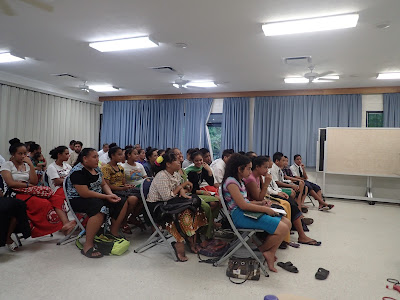The Department Of Marine & Wildlife Resources

Wednesday, May 25, 2016
Tuesday, May 24, 2016
Tuesday, March 22, 2016
Community Outreach Program at Amaua & Auto Village
All life on Earth is connected to the ocean and it's inhabitants. The more you learn about the issues facing this vital system, the more you'll want to help ensure it's health then share the knowledge to educate and inspire others. Community Outreach Program gives the Community an opportunity to get involved and become good stewardship in preserving their natural resources that they can sustainably maintain and harvest in the future. Empowering our Communities that Conserving our Reefs we'll restore abundance and return sustainable fishing within our Village Marine Protected Areas of American Samoa!
Different Types of Marine Protected Area's Presentation
Photos: Faleselau Tuilagi
Different Types of Marine Protected Area's Presentation
Photos: Faleselau Tuilagi
Maina Bird Eradication Presentation
Photos: Faleselau Tuilagi
" Our Reef, Our Resources, Our Future".
Monday, February 1, 2016
Sea Level Rise In American Samoa
American Samoa has a tropical climate moderated by southeast
trade winds. There is minimal variation in seasonal temperature. American Samoa
has a rainy season from November to April and a dry season from May to October.
Typhoons are common from December to March, and it is predicted that these will
increase as a result of climate change. Climate Change, specifically sea-level
rise, directly impacts American Samoa by increasing flooding or drought
conditions. There are limited natural freshwater resources in American Samoa
and these may be adversely affected by a rise in the level of saltwater
penetration under the island caused by sea level rise.
Sea level rise in Nu’uuli, perhaps the most significant negative effect higher global temperatures
is the rise in sea levels resulting from the thermal expansion (warming causes seawater
to expand) of the oceans and melting of ice-caps. It is projected that sea levels will rise
by as much as 5 mm per year over the next 100 years as a result of global warming.
Utilizing the coarse data currently available to the
territory, the American Samoa Coastal Zone
Management division developed projection of the
areas of Tutuila that may be impacted by a meter
rise in sea level. Across the island critical sections
of primary roads as well as private and public
structures may be affected. The village of Nu’uuli
and the airport, in particular, are expected to be
heavily impacted. Large portions of the airport runway and most of
Coconut Point may become inundated by seawater.
Sea level rise, combined with erosion of the coast
and reef, could seriously disrupt transportation to
and around the islands, and reduce public access to
critical services such as the hospital.
Photo Courtesy: Alice Lawrence
Climate change will impact coral reefs and coastal
communities through the effects of sea level rise, changes in storm and
rainfall frequency and intensity, increased sea surface temperatures and ocean
acidification. Models and vulnerability assessments can prepare communities for
potential impacts through planning for climate resiliency. A climate resilient
community is better prepared to effectively protect people, society, culture and
resources from a changing climate.
" OUR ISLAND, OUR PATIENTS, OUR FUTURE", "CLIMATE ACTION NOW FOR EVERYONE'S SAKE". LET'S MOVE FORWARD AMERICAN SAMOA!
" OUR ISLAND, OUR PATIENTS, OUR FUTURE", "CLIMATE ACTION NOW FOR EVERYONE'S SAKE". LET'S MOVE FORWARD AMERICAN SAMOA!
Subscribe to:
Comments (Atom)















